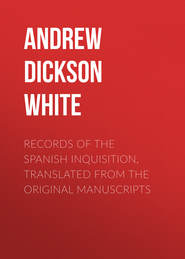По всем вопросам обращайтесь на: info@litportal.ru
(©) 2003-2025.
✖
The Warfare of Science
Настройки чтения
Размер шрифта
Высота строк
Поля
104
Henri Martin, Histoire de France, vol. xii., pp. 14, 15.
105
Napier, Florentine History, vol. v., p. 485. Tiraboschi, Storia della Literatura. Henri Martin, Histoire de France. Jevons Principles of Science, vol. ii., pp. 36-40. For value attached to Borelli's investigations by Newton and Huyghens, see Brewster'sLife of Sir Isaac Newton, London, 1875, pp. 128, 129. Libri, in his Essai sur Galilée, p. 37, says that Oliva was summoned to Rome, and so tortured by the Inquisition that, to escape further cruelty, he ended his life by throwing himself from a window.
106
For this syllogism, see Figuier, L'Alchimie et les Alchimistes, pp. 106, 107. For careful appreciation of Becher's position in the history of chemistry, see Kopp, Ansichten über die Aufgabe der Chemie, etc., von Geber bis Stahl, Braunschweig, 1875, pp. 201, et seq.
107
For Tertullian's views, see the De Anima, chap. x. For views of St. Augustine, see the De Civ. Dei, book xxii., chap. 24.
108
For Boniface VIII. and his interdiction of dissections, see Buckle's Posthumous Works, vol. ii., p. 567. For injurious effects of this ecclesiastical hostility to anatomy upon the development of art, see Woltman, Holbein and His Time, pp. 266, 267. For an excellent statement of the true relation of the medical profession to religious questions, see Prof. Acland, General Relations of Medicine in Modern Times, Oxford, 1868. For thoughtful and witty remarks on the struggle at a recent period, see Maury, L'Ancienne Académie des Sciences, Paris, 1864, p. 148. Maury says: "La faculté n'aimait pas à avoir affaire aux théologiens qui procèdent par anathèmes beaucoup plus que par analyses."
109
For uncritical praise of Arnold de Villa Nova, see Figuier, L'Alchimie et les Alchimistes, 3ème edit. For undue blame, see Hoefer, Histoire de la Chimie, Paris, 1842, vol. i., p. 386. For a more broad and fair judgment, see Kopp, Geschichte der Chemie, Braunschweig, 1843, vol. i., p. 66, and vol. ii., p. 185. Also, Pouchet, Histoire des Sciences Naturelles au Moyen Age, Paris, 1853, pp. 52, et seq. Also, Draper, Int. Dev. of Europe, p. 421. Whewell, Hist. of the Induct. Sciences, vol. i., p. 235; vol. viii., p. 36. Frédault, Hist. de la Médecine, vol. i., p. 204.
110
Renan, Averroès et l'Averroisme, Paris, 1867, pp. 327, 333, 335. For a perfectly just statement of the only circumstances which can justify the charge of "atheism," see Dr. Deems's article in Popular Science Monthly, February, 1876.
111
Whewell, vol. iii., p. 328, says, rather loosely, that Mundinus "dissected at Bologna in 1315." How different his idea of dissection was from that introduced by Vesalius, may be seen by Cuvier's careful statement that the entire number of dissections by Mundinus was three. The usual statement is that it was two. See Cuvier, Hist. des Sci. Nat., tome iii., p. 7; also, Sprengel, Frédault, and Hallam; also, Littré, Médecine et Médecins, chap. on anatomy. For a very full statement of the agency of Mundinus in the progress of anatomy, see Portal, Hist. de l'Anatomie et de la Chirurgérie, vol. i., pp. 209-216.
112
For a similar charge against anatomical investigations at a much earlier period, see Littré, Médecine et Médecins, chapter on anatomy.
113
The original painting of Vesalius at work in his cell, by Hamann, is now at Cornell University.
114
For a curious example of weapons drawn from Galen and used against Vesalius, see Lewes, Life of Goethe, p. 343, note. For proofs that I have not over-estimated Vesalius, see Portal, ubi supra. Portal speaks of him as "le génie le plus droit qu'eut l'Europe;" and again, "Vesale me paraît un des plus grands hommes qui ait existé."
115
See Sprengel, Histoire de la Médecine, vol. vi., pp. 39-80. For the opposition of the Paris Faculty of Theology to inoculation, see the Journal de Barbier, vol. vi., p. 294. For bitter denunciations of inoculation by the English clergy, and for the noble stand against them by Maddox, see Baron, Life of Jenner, vol. i., pp. 231, 232, and vol. ii., pp. 39, 40. For the strenuous opposition of the same clergy, see Weld, History of the Royal Society, vol. i., p. 464, note. Also, for the comical side of this matter, see Nichols's Literary Illustrations, vol. v., p. 800.
116
For the opposition of conscientious men in England to vaccination, see Duns, Life of Sir James Y. Simpson, Bart., London, 1873, pp. 248, 249; also, Baron, Life of Jenner, ubi supra, and vol. ii., p. 43; also, Works of Sir J. Y. Simpson, vol. ii.
117
See Duns, Life of Sir J. Y. Simpson, pp. 215-222.
118
Ibid., pp. 256-259.
119
Ibid., p. 260; also, Works of Sir J. Y. Simpson, ubi supra.
120
Morley, Life of Palissy the Potter, vol. ii., pp. 315, et seq.
121
Audiat, Vie de Palissy, p. 412. Cantu, Hist. Universelle, vol. xv., p. 492.
122
For ancient beliefs regarding giants, see Leopardi, Saggiosopra gli errori popolari, etc., chapter xv. For accounts of the views of Mazurier and Scheuchzer, see Büchner, Man in Past, Present, and Future, English translation, pp. 235, 236. For Increase Mather's views, see Philosophical Transactions, xxiv., 85. For similar fossils sent from New York to the Royal Society as remains of giants, see Weld, History of the Royal Society, vol. i., p. 421. For Father Torrubia and his Gigantologia Española, see D'Archiac, Introduction à l'Étude de la Paléontologie stratiographique, Paris, 1864, p. 202. For admirable summaries, see Lyell, Principles of Geology, London, 1867; D'Archiac, Géologie et Paléontologie, Paris, 1866; Pictet, Traité de Paléontologie, Paris, 1853; Vezian, Prodrome de la Géologie, Paris, 1863; Haeckel, History of Creation, New York, 1876, chapter iii.
123
See Voltaire, Dissertation sur les Changements arrivés dans notre Globe; also, Voltaire, Les Singularités de la Nature, chapter xii., near close of vol. v. of the Didot edition of 1843; also, Jevons, Principles of Science, vol. ii., p. 328.
124
For a candid summary of the proofs from geology, astronomy, and zoölogy, that the Noachian Deluge was not universally or widely extended, see McClintock and Strong, Cyclopædia of Biblical Theology and Ecclesiastical Literature, article Deluge. For general history, see Lyell, D'Archiac, and Vezian. For special cases showing bitterness of the conflict, see the Rev. Mr. Davis's Life of Rev. Dr. Pye Smith, passim.
125
For comparison between conduct of Italian and English ecclesiastics, as regards geology, see Lyell, Principles of Geology, tenth English ed., vol i., p. 33. For a philosophical statement of reasons why the struggle was more bitter, and the attempt at deceptive compromises more absurd in England than elsewhere, see Maury, L'Ancienne Académie des Sciences, second edition, p. 152.
126
For these citations, see Lyell, Principles of Geology, introduction.
127
See Pye Smith, D. D., Geology and Scripture, pp. 156, 157, 168, 169.
128
Wiseman, Twelve Lectures on the Connection between Science and Revealed Religion, first American edition, New York, 1837.







